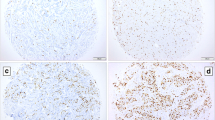Abstract
Gene mutation status assessment of tumors has become standard practice in diagnostic pathology. This is done using samples comprising tumor cells but also non-tumor cells, which may dramatically dilute the proportion of tumor DNA and induce false negative results. Increasing sensitivity of molecular tests presently allows detection of a targeted mutation in a sample with a small percentage of tumor cells, but assessment of tumor cellularity remains essential to adequately interpret the results of molecular tests. Comprehensive tumor cell counting would provide the most reliable approach but is time consuming, and therefore rough global estimations are used, the reliability of which has been questioned in view of their potential clinical impact. The French association for quality assurance in pathology (AFAQAP) conducted two external quality assurance schemes, partly in partnership with the French group of oncology cytogenomics (GFCO). The purpose of the schemes was to (1) evaluate how tumor cellularity is assessed on tissue samples, (2) identify reasons for discrepancies, and (3) provide recommendations for standardization and improvement. Tumor cell percentages in tissue samples of lung and colon cancer were estimated by 40–50 participants, on 10 H&E virtual slides and 20 H&E conventional slides. The average difference between lowest and highest estimated percentage was 66. This was largely due to inadequate definition of cellularity, reflecting confusion between the percentage of tumor cells and the percentage of the area occupied by tumor in the assessed region. The widest range of interobserver variation was observed for samples with dense or scattered lymphocytic infiltrates or with mucinous stroma. Estimations were more accurate in cases with a low percentage of tumor cells. Macrodissection of the most homogeneous area in the tissue reduced inter-laboratory variation. We developed a rating system indicating potential clinical impact of a discrepancy. Fewer discrepancies were clinically relevant since the study was conducted. Although semi-quantitative estimations remain somewhat subjective, their reliability improves when tumor cellularity is adequately defined and heterogeneous tissue samples are macrodissected for molecular analysis.



Similar content being viewed by others
References
Paez JG, Jänne PA, Lee JC, Tracy S, Greulich H, Gabriel S, Herman P, Kaye FJ, Lindeman N, Boggon TJ, Naoki K, Sasaki H, Fujii Y, Eck MJ, Sellers WR, Johnson BE, Meyerson M (2004) EGFR mutation in lung cancer: correlation with clinical response to gefitinib therapy. Science 304:1497–1500
Lynch TJ, Bell DW, Sordella R, Gurubhagavatula S, Okimoto RA, Brannigan BW, Harris PL, Haserlat SM, Supko JG, Haluska FG, Louis DN, Christiani DC, Settleman J, Haber DA (2004) Activating mutations in the epidermal growth factor receptor underlying responsiveness of non-small-cell lung cancer to gefinitib. N Engl J Med 350:2129–2139
Pao W, Miller V, Zakowski M, Doherty J, Politi K, Sarkaria I, Singh B, Heelan R, Rusch V, Fulton L, Mardis E, Kupfer D, Wilson R, Kris M, Varmus H (2004) EGF receptor gene mutations are common in lung cancers from “never smokers” and are associated with sensitivity of tumors to gefitinib and erlotinib. Proc Natl Acad Sci U S A 101:13306–13331
Smits AJ, Kummer JA, de Bruin PC, Bol M, van den Tweel JG, Seldenrijk KA, Willems SM, Offerhaus GJ, de Weger RA, van Diest PJ, Vink A (2014) The estimation of tumor cell percentage for molecular testing by pathologists is not accurate. Mod Pathol 27:168–174. doi:10.1038/modpathol.2013.134
Viray H, Li K, Long TA, Vasalos P, Bridge JA, Jennings LJ, Halling KC, Hameed M, Rimm DL (2013) A prospective, multi-institutional diagnostic trail to determine pathologist accuracy in estimation of percentage of malignant cells. Arch Pathol Lab Med 137:1545–1549. doi:10.5858/arpa.2012-0561-CP
RBPACP Annexe 7 https://www.afaqap.fr/sites/default/files/rbpacp v2 annexe 7 1.pdf
Dequeker EM, Keppes C, Egele C, Delen S, Lamy A, Lemoine A, Sabourin JC, Andrieu C, Ligtenberg M, Fetique D, Tops B, Descarpentries C, Bons H, Denoux Y, Aube C, Penault-Lorca F, Hofman P, Leroy K, le Marechal C, Doucet L, Duranton-Tanneur V, Pedeutour F, Soubeyran I, Côté JF, Emile JF, Vignaud JM, Monhoven N, Haddad V, Laurent-Puig P, van Krieken H, Nowak F, Lonchamp E, Bellocq JP, Rouleau E (2016) Three rounds of external quality assessment in France to evaluate the performance of 28 platforms for multiparametric molecular testing in metastatic colorectal and non small cell lung cancer. J Mol Diagn 18:205–214. doi:10.1016/j.jmoldx.2015.09.004
Dijkstra JR, Heideman DA, Meijer GA, Boers JE, ‘t Hart NA, Diebold J, Hirschmann A, Hoefler G, Winter G, Miltenberger-Miltenyi G, Pereira SV, Richmqn SD, Quirke P, Rouleau EL, Guinebretiere JM, Tejpar S, Biesmans B, van Krieken JH (2013) KRAS mutation analysis on low percentage of colon cancer cells: the importance of quality assurance. Virchow Arch 426:39–46. doi: 10.1007/s00428-012-1356-2
Van Krieken JH, Rouleau E, Ligtenberg MJ, Normanno N, Patterson SD, Jung A (2016) RAS testing in metastatic colorectal cancer: advances in Europe. Virchow Arch 468:383–396. doi:10.1007/s00428-015-1876-7
Author information
Authors and Affiliations
Corresponding author
Ethics declarations
This chapter does not contain any studies with human participants or animals performed by any of the authors.
Conflict of interest
The authors declare that they have no conflicts of interest.
Rights and permissions
About this article
Cite this article
Lhermitte, B., Egele, C., Weingertner, N. et al. Adequately defining tumor cell proportion in tissue samples for molecular testing improves interobserver reproducibility of its assessment. Virchows Arch 470, 21–27 (2017). https://doi.org/10.1007/s00428-016-2042-6
Received:
Revised:
Accepted:
Published:
Issue Date:
DOI: https://doi.org/10.1007/s00428-016-2042-6




